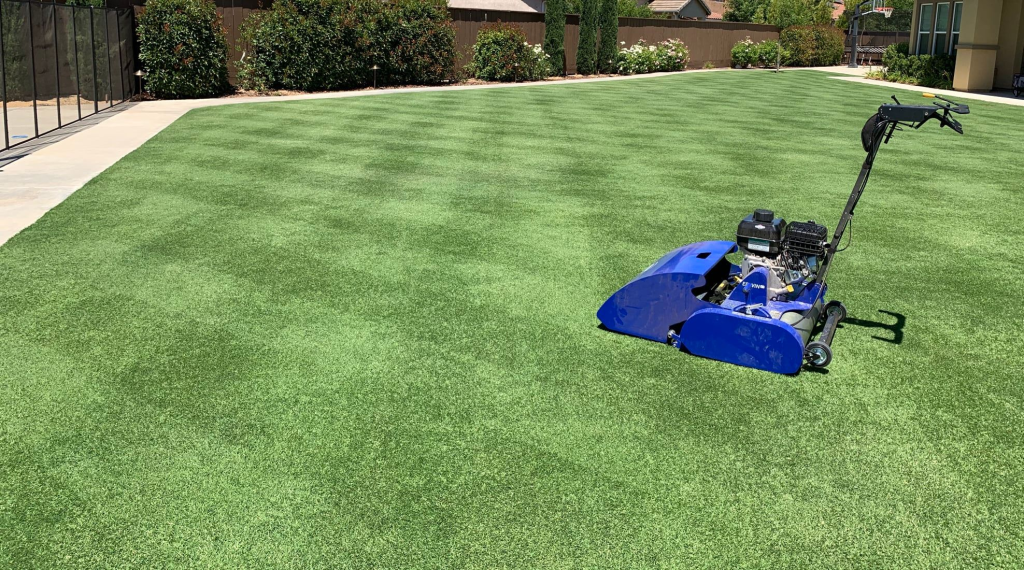If you’re a proud homeowner with a bermudagrass lawn, you already know that this turf is a top choice for hot, sunny climates. But even the best lawns can go awry without proper mowing. The height at which you cut your bermudagrass and the type of mower you use can make or break your lawn’s health and appearance. In this article, we’re zeroing in on the specific height requirements for mowing bermudagrass and discussing the pros and cons of reel vs. rotary mowers.
Height Requirements
Ideal Hybrid Bermudagrass Height: 0.38 to 1.5 inches
For optimal health and aesthetics, aim to maintain your bermudagrass between 0.38 and 1.5 inches in height. While it can tolerate heights up to 3 inches, keeping it shorter will yield the best results. Keeping it short will force the bermudagrass to spread, meaning it will thicken up like a mat. You’ll be making it grow horizontally instead of vertically which helps suffocate weeds and make the lawn thicker.
Ideal Common Bermudagrass Height: 1 to 2 inches
According to Texas A&M, common bermudagrass should be mowed higher than hybrid. However, that doesn’t mean common must be above 1 inches. If you prefer lower, go lower.
According to credentialled professors L.B. McCarty and Grady Miller, who have wrote extensively on the topic, common bermudagrasses are not used on golf greens but rather roughs and less so on fairways. Hybrid performs better at low heights.
2 Reasons To Cut Low
There are multiple reasons to cut bermudagrass short. It’s a common myth that it needs to be cut higher and some people come up with almost any excuse on why their lawn is an exception and needs to be mowed higher like it’s fescue.
Reason #1: Improved Weed Resistance
There was a study in 1990 and 1991 that tested mowing height of bermudagrass containing crabgrass.
There was a positive linear response to cutting height in 1991, meaning as the cutting height increased, the percentage of crabgrass also increased. This indicates that higher cutting heights may favor the growth of crabgrass within the mixture.
Reason #2: Cutting Short Increases Growth
Bermuda likes being cut short and when cut short, it grows more. In the above study, there was a linear decrease in dry matter yield as cutting height increased. This suggests that lower cutting heights could be more beneficial for maximizing the biomass yield of bermudagrass.

Adjusting Height in Shade
When dealing with shady areas, it’s best to keep a higher height-of-cut, in order to maximize leaf surface area to compensate for the lower amount of light. Similarly, shady areas will also require less fertilizer than full-sun areas.
Seasonal Scalping: A Springtime Must-Do
Come February or March, as temperatures start to rise, it’s time to scalp your bermudagrass lawn.

This means mowing it down as low as you can. There is no such thing as too low. bermudagrass is resilient and will bounce back thanks to its network of rhizomes and stolons. Some folks will even burn (yes with fire) their lawn instead of scalping.

Peak Season Maintenance: The June-August Hustle
During the high-growth months of June through August, be prepared to mow your bermudagrass 2-3 times a week to keep it in prime condition. The top lawns will be mowed daily unless they’re on PGR.
Reel vs. Rotary Mowers: Choose Wisely

Reel Mowers
- Pros: Ideal for lower cuts, reel mowers offer a clean, precise cut that’s healthier for your bermudagrass. It’s like cutting your lawn with scissors instead of a hatchet.
- Cons: They can be labor-intensive, require more maintenance and are less available.
Rotary Mowers
- Pros: These mowers are versatile and can handle a variety of heights which is great for contractors who mow lawns of all types (tall fescue, St. Augustine, etc). They’re also more common, faster and require less manual effort. They are cheaper than reel mowers (excluding manual reel mowers).
- Cons: The fast-spinning blades can tear the grass, potentially making your Bermuda lawn more susceptible to diseases. They also don’t do well under 1 inch and they bounce a lot on a bumpy lawn.
The Verdict: Which Mower for Your Bermuda Lawn?
Rotary mowers are generally more likely to scalp the lawn compared to reel mowers. Scalping occurs when the mower cuts the grass too short, exposing the soil. Rotary mowers, which use a horizontally spinning blade, can easily scalp uneven terrain or if the blades are set too low. Reel mowers, on the other hand, use a scissor-like cutting action and can follow the contours of the ground more closely, reducing the likelihood of scalping.
For bermudagrass, which thrives at lower heights, a reel mower is generally your best bet. It offers a cleaner, healthier cut that will make your lawn look its best.
Check out the best manual reel mowers and the best gas reel mowers here.

Conclusion
When it comes to bermudagrass, mowing low and frequently is essential to a strong lawn. The right mowing height and the right type of mower are crucial for maintaining a lawn that’s both healthy and visually appealing. So grab your mower of choice and get ready to give your bermudagrass the VIP treatment it deserves. Your lawn—and your neighbors—will thank you.
Leave a Reply